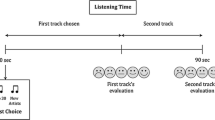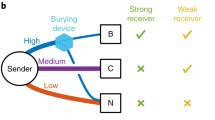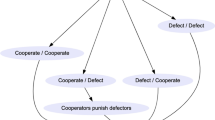Abstract
We propose a generic model for multiple choice situations in the presence of herding and compare it with recent empirical results from a Web-based music market experiment. The model predicts a phase transition between a weak imitation phase and a strong imitation, ‘fashion’ phase, where choices are driven by peer pressure and the ranking of individual preferences is strongly distorted at the aggregate level. The model can be calibrated to reproduce the main experimental results of Salganik et al. (Science, 311, 854–856 (2006)); we show in particular that the value of the social influence parameter can be estimated from the data. In one of the experimental situation, this value is found to be close to the critical value of the model.
Similar content being viewed by others
References
Bass F.M. (1969). A new product growth model for consumer durables. Manage. Sci. 15: 215–227
Bikhchandani S., Hirshleifer D. and Welch I. (1992). A theory of fads, fashions, custom and cultural changes as informational cascades. J. Polit. Econ. 100: 992–1026
Borghesi Ch. and Galam S. (2006). Chaotic, staggered and polarized dynamics in opinion forming: the contrarian effect. Phys. Rev. E 73: 066118–066124
Bouchaud, J.P.: Power-laws in economics and finance: some ideas from physics, Quantitative Finance, 1, 105–112 (2001); Bouchaud, J.-P., Potters, M.: Theory of Financial Risks and Derivative Pricing. Cambridge University Press (2003)
Challet, D., Marsili, M., Zhang, Y.C.: Minority Games. Oxford University Press (2005)
Cont R. and Bouchaud J.P. (2000). Herd behaviour and aggregate fluctuations in financial markets. Macroecon. Dynam. 4: 170–196
Curty, Ph., Marsili, M.: Phase coexistence in a forecasting game. J. Stat. Mech. P03013 (2006)
for a recent review: de Martino, A., Marsili, M.: Statistical mechanics of socio-economic systems with heterogeneous agents, physics/0606107
Föllmer H. (1974). Random economies with many interacting agents. J. Math. Econ. 1: 51–62
Galam, S.: Majority rule, hierarchical structure and democratic totalitarism. J. Math. Psychol. 30, 426–434 (1986); Galam, S., Moscovici, S.: Towards theory of collective phenomena: consensus and attitude changes in groups. Euro. J. Social Psy. 21, 49–74 (1991); Galam, S.: Rational group decision making: a RFIM at T = 0, Phys A 238, 66–80 (1997)
Granovetter, M.: Threshold models of collective behaviour. Am. J. Sociol. 83,1420–1443 (1978); Granovetter, M., Soong, R.: Threshold models of diffusion and collective behaviour. J. Math. Socio. 9, 165–179 (1983); Granovetter, M., Soong, R.: Threshold models of interpersonal effects in consumer demand. J. Econ. Behav. Organ. 7, 83–99 (1986); Granovetter, M., Soong, R.: Threshold models of diversity: Chinese restaurants, residential segregation and the spiral of silence, in Sociological Methodology, C. Clogg Edt. (1988), p. 69–104.
Guedj O. and Bouchaud J.P. (2005). Experts earning forecasts, bias, herding and gossamer information. J. Theor. Appl. Finance 8: 933–946
Kirman A. (1993). Ants, rationality and recruitment. Quart. J. Econ. 108: 137–156
Laureti P., Ruch P., Wakeling J. and Zhang Y.C. (2004). The Interactive minority game: a Web-based investigation of human market interactions. Phys. A 331: 651–659
Michard Q. and Bouchaud J.-P. (2005). Theory of collective opinion shifs: from smooth trends to abrupt swings. Eur. J. Phys. B 47: 151–159
Nadal, J.-P., Phan, D., Gordon, M.B., Vannimenus, J.: Multiple equilibria in a monopoly market with heterogeneous agents and externalities. Quantitative Finance 5 557–568 (2005); Gordon, M.B., Nadal, J.-P., Phan, D., Vannimenus, J.: Seller’s dilemma due to social interactions between customers. Phys. A 356 628–640 (2005)
Orléan A. (1995). Bayesian interactions and collective dynamics of opinions. J. Econ. Behav. Organ. 28: 257–274
Redner, S.: Citation Statistics From More Than a Century of Physical Review, Physics Today, p. 49–52, June 2005
Salganik M.J., Dodds P.S. and Watts D.J. (2006). Experimental study of inequality and unpredictability in an artificial cultural market. Science 311: 854–856
Schelling, T.: Micromotives and Macrobehaviour. W W Norton & Co Ltd (1978)
Sethna, J., Dahmen, K., Myers, C.: Crackling noise. Nature, 410, 242–250 (2001); Sethna, J., Dahmen, K., Perkovic, O.: Random Field Ising Models of Hysteresis, cond-mat/0406320
Simkin, M.V., Roychowdhury, V.P.: Copied citations create renowned papers? Annals of Improbable Research 11(1), 24–27 (2005); Simkin, M.V., Roychowdhury, V.P.: Stochastic modeling of citation slips, Scientometrics, 62, 367–370 (2005)
Slanina F. and Zhang Y.C. (2005). Referee networks and their spectral properties.. Acta Phy. Polonica B 36: 2797–2804
Steyer, A.: Géométrie des interactions sociales et modèles de diffusion des innovations, working paper, GREQAM (2002)
Author information
Authors and Affiliations
Corresponding author
Rights and permissions
About this article
Cite this article
Borghesi, C., Bouchaud, JP. Of songs and men: a model for multiple choice with herding. Qual Quant 41, 557–568 (2007). https://doi.org/10.1007/s11135-007-9074-6
Published:
Issue Date:
DOI: https://doi.org/10.1007/s11135-007-9074-6




